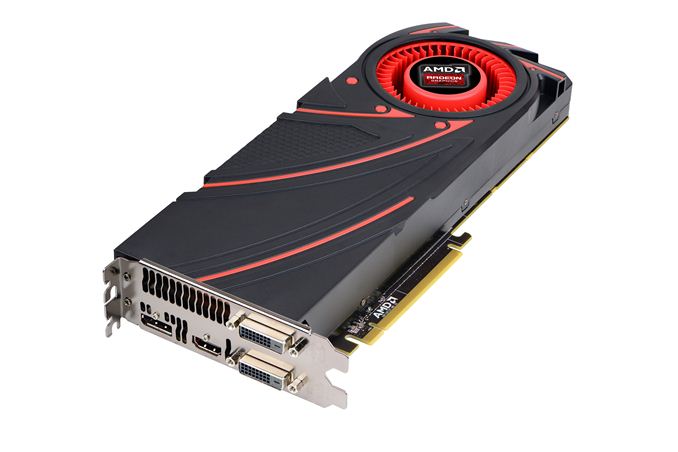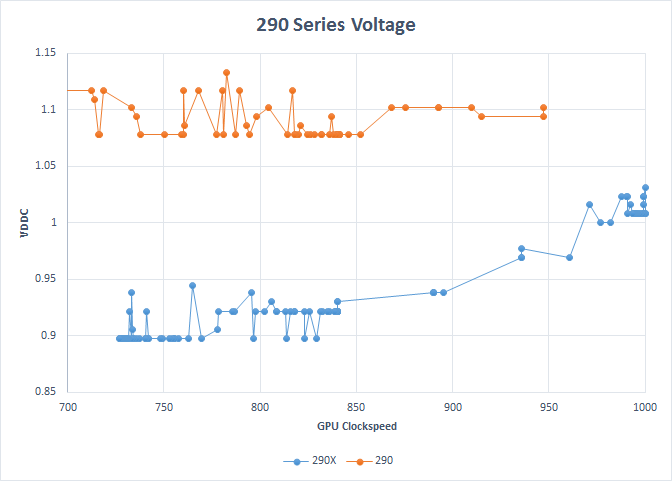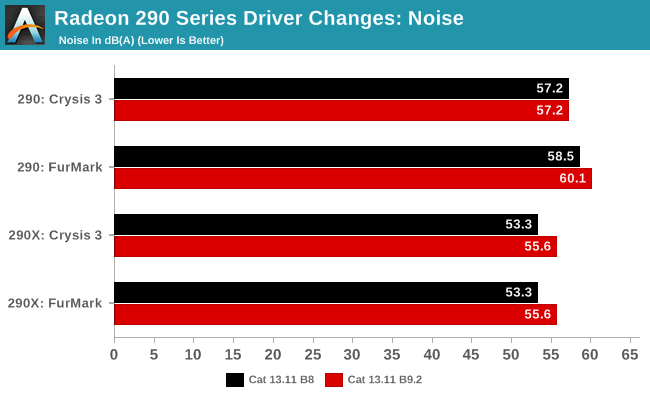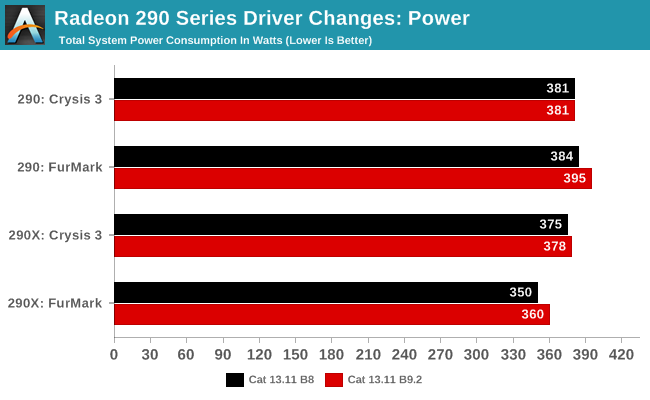AMD Changes 290 Series Fan Algorithms & About That 290 Conclusion
by Ryan Smith on November 9, 2013 3:48 PM EST- Posted in
- GPUs
- AMD
- Radeon
- Radeon 200

In a busy week that’s going to end up being just a bit busier, AMD has pushed out another Catalyst driver update specifically targeted at the new Radeon R9 290 series, Catalyst 13.11 Beta9.2. This release is especially notable because it resolves some outstanding issues with the hardware that the hardware press has covered in depth this week opposite the 290 launch, and because it is making low level operational changes that will have a direct impact on the power, noise, and performance characteristics of the 290 series.
First off, let’s talk about what AMD has done with their drivers. Citing an issue with variability in the fan speeds on 290 series cards, AMD has changed the algorithms for how their drivers handle the fan speeds on 290 series cards, essentially overriding the BIOS defaults with new values. This is similar to how AMD deployed their specification changes for the 290 ahead of its launch – adjusting it from 40% to 47% as the default maximum fan speed – but AMD has also used their driver update to change how they’re defining and controlling fan speeds.
Rather than controlling fan speed based on percentages, which are really measuring fan speed as the duty cycle of the fan’s motor on a relative basis, AMD has switched to controlling fan speeds on an absolute basis, using the measured RPM of the fan as their metric of absolute fan speed. This goes back to AMD’s concern over variance, as there is going to be some variance – and apparently too much variance – from fan motor to fan motor in how fast it can go, and consequently just what a specific duty cycle represents on a relative basis. Consequently by switching to measuring fan speed on an absolute basis there will definitely be less variation. as AMD is now controlling fan speeds by the very same metric they use to define that variation (RPM).
For the release of this driver, this is what AMD specifically had to say.
We’ve identified that there’s variability in fan speeds across AMD R9 290 series boards. This variability in fan speed translates into variability of the cooling capacity of the fan-sink.
The flexibility of AMD PowerTune technology enables us to correct this variability in a driver update. This update will normalize the fan RPMs to the correct values.
Given the significant interest there has been this week in articles published over at Tom’s Hardware and their experience with additional retail 290 series cards, it's likely that this is related to the issues Tom’s was seeing. In which case the implication is that fans are running too slow, which could've definitely resulted in lower performing cards. It's obviously also possible that fans could be running too fast in some configurations, which would obviously result in louder/higher performing cards. The third scenario that this update corrects is one that AMD told us about: where the fans are running too slow during light-to-medium workloads, which in turn allows the GPU to heat up more than it should and forces the fan to run at higher speeds down the line. In this third scenario, the overall acoustic profile of the card would actually be quieter post update. Admittedly this isn't something we test for or something we've seen internally, but it's a situation that AMD says also improves with this update.
Along with reducing variation the net result of this driver as far as our samples are concerned will be that fan speeds are going to go up. AMD’s new maximum fan speeds for the 290X (quiet mode) and 290 will be 2200RPM and 2650RPM respectively. A quick meta-analysis doesn’t show any site as having reported their review samples as having RPMs that high or higher, in which case the situation should be similar to ours. Our cards topped out at 2100RPM for the 290X and 2500RPM for the 290, so these new values represent a 100RPM and 150RPM increase in default fan speeds respectively. Or on a percentage basis, we’ve gone from 40% to 42% for the 290X, and 47% to 49% for the 290.
| AMD Radeon R9 290 Series Maximum Fan Speeds | |||||||||||
| Card | Catalyst 13.11 Beta 8 | Catalyst 13.11 Beta 9.2 | |||||||||
| 290X (Quiet Mode) | ~2100 RPM (40%) | ~2200RPM (42%) | |||||||||
| 290 | ~2500 RPM (47%) | ~2650 RPM (49%) | |||||||||
Since we don’t have any other 290 cards at this time, and our second 290X already behaved virtually identical to our first, we’re not in a position to talk about the matter of variance in further detail. Presumably variance was a big enough issue that it required AMD’s quick attention, but we don’t have any further cards to get a first-hand impression of just how large that variance was. Whatever the variance was though, this should virtually eliminate it.
What we can briefly look at however is how this changed our performance results. The net effect of this change is that AMD has increased their fan speeds for the 290 series, and as a result noise levels are going to go up slightly, and due to the close relationship between noise, cooling, and heat dissipation, power consumption will also go up slightly too. We’d say performance is going to go up too (again similar to the 290’s spec change), but in reality the amount of variance caused by PowerTune has all but drowned out any possible performance difference on our 290X. Meanwhile our 290 wasn’t cooling limited in the first place, so this change hasn’t affected gaming performance.
With respect to PowerTune on the 290X, we’ve been finding that PowerTune adjusts clockspeeds rather significantly in response to the smallest input changes, which makes it difficult to isolate any resulting performance changes from the fan speed adjustment. The reason why this is happening is unclear, but we suspect that it has to do with the 290 series cards not having much flexibility to adjust their voltages, resulting in them having to instead widely adjust their clockspeeds to achieve the necessary reduction in power consumption and heat generation.
To put this concept to the test, here are some quick scatter plots of the 290 and 290X running FurMark, plotting clockspeed against voltage (VDDC) as measured by GPU-Z. These voltages are going to be subject to external factors such as vDroop, but it’s the best we have right now since we can’t see VIDs.

In brief, there’s only roughly a 100mv difference in voltages between the 290X’s base clockspeed and boost clockspeed, and even less a difference on the 290. If this data is reasonably accurate, then it would explain why the 290 series sees such heavy clockspeed throttling at times, and why our gaming performance hasn’t changed. So with that in mind, let’s look at the numbers.

First and foremost, noise under load has predictably gone up. For the 290X where FurMark and Crysis 3 top out at the same point, this new noise level is 55.6dB, 2.3dB higher than the old maximum of 53.3dB. For the 290 on the other hand, noise levels don’t change under Crysis 3 since it wasn’t cooling/fan limited in the first place, remaining at 57.2dB. However the worst case scenario, as represented by FurMark, sees noise levels increase a further 1.6dB to 60.1dB.

As for power consumption, since we’re clearly cooling limited in most scenarios on the 290 series, any increase in cooling performance causes an increase in power consumption. For the 290X in FurMark this is another 10W at the wall, while under Crysis 3 (where performance is nearly identical) this is a barely measurable 3W difference. While for the 290 the difference is 11W for FurMark, and absolutely nothing for Crysis 3 since it wasn’t cooling limited in the first place.

Finally for performance, we can see that the fan speed adjustments had no measurable impact on performance under Crysis. The 290 was never cooling limited in the first place, and for the voltage issues discussed further, PowerTune has all but wiped out any potential performance improvement for the 290X, leaving it changed by a fraction of a frame per second. Unfortunately this means the noise increase is very real, but there’s not a measurable performance increase to go with it.
With all of that said, this won’t be impacting our reviews of the 290 or 290X (or GTX 780 Ti), as there isn’t a performance change to account for, and the noise change, though unfortunate, is under gaming workloads limited to the 290X (though this does mean 290X loses some further ground to 290).
About that 290 Conclusion
Since we’re already on the matter of our recommendations, I wanted to spend a bit of time following up on our 290 review, as that review and its conclusion generated a lot more feedback than we had been expecting. In this week’s article I flat out avoided recommending the 290 because of its acoustic profile. When faced with the tradeoff of noise vs. performance, AMD clearly chose the latter and ended up with a card that delivers a ridiculous amount of performance for $399 but exceeds our ideas of comfortable noise levels in doing so.
I personally value acoustics very highly and stand by my original position that the reference R9 290 is too loud. When I game I use open back headphones so I can listen for phone calls or the door for shipments, and as a result acoustics do matter to me. In the review I assumed everyone else valued acoustics at least similarly to me, but based on your reaction it looks like I was mistaken. While a good number of AnandTech readers agreed the R9 290 was too loud, an equally important section of the audience felt that the performance delivered was more than enough to offset the loud cooling solution. We want our conclusions to not only be reflective of our own data, but also be useful to all segments of our audience. In the case of the 290 review, I believe we accomplished the former but let some of you down with the latter.
Part of my motivation here is to make sure that we send the right message to AMD that we don’t want louder cards. I believe that message has been received loud and clear from what I understand. It’s very important to me that we don’t send the message to AMD or NVIDIA that it’s ok to engage in a loudness war in the pursuit of performance; we have seen a lot of progress in acoustics and cooler quality since the mid-to-late 2000’s, and we’d hate to see that progress regressed on. A good solution delivers both performance and great user experience, and I do believe it’s important that we argue for both (which is why we include performance, power and noise level data in our reviews).
The Radeon R9 290 does offer a tremendous value, and if you’re a gamer that can isolate yourself from the card’s acoustics (or otherwise don’t care) it’s easily the best buy at $399. If acoustics are important to you, then you’re in a tougher position today. There really isn’t an alternative if you want R9 290 performance at the same price. The best recommendation I have there is to either pony up more cash for a quieter card, accept the noise as is or wait and see what some of the customized partner 290 cards look like once those do arrive. I suspect we’ll have an answer to that problem in the not too distant future as well.
Note that this isn't going to be the last time performance vs. acoustics are going to be a tradeoff. AMD pointed out to us that the 290/290X update is the first time its fan speed has been determined by targeting RPMs vs. PWM manipulation. In the past, it didn't really matter since performance didn't scale all that much with fan speed. Given the current realities of semiconductor design and manufacturing, the 290/290X situation where fan speed significantly impacts performance is going to continue to be the case going forward. We've already made the case to AMD for better reference cooling designs and it sounds like everyone is on the same page there.
Given the amount of interest this has generated I'm curious to get your feedback on the performance vs. acoustic debate. Feel free to share your comments below on how important acoustics are for you (vs. performance) and at what point does a GPU become too loud? For us the reference point was NVIDIA's GeForce GTX 480, but I'm interested to know what GPUs in your past have been too loud.










141 Comments
View All Comments
jenneth - Monday, November 11, 2013 - link
>> I'm not sure what your point is with this. Of course open systems, or speakers, can be good >> also.>> But you asserted that any "decent audio system" was very sensitive to noise, which is wrong.
My point is that a good open system (open headphones or near-field/Mid-range monitors) will always beat an IEM system. Now, a great CIEM like the 1plus2 would shrink the gap I admit, but those still wouldn’t beat an open system. What you consider to be a ‘decent’ audio system isn’t decent enough for me and others.
>> Look for $350-400+ cards… to find the GTX 670, at 1.48%. The next one, the 680, is another >> 16 places down at 1.09%, and it's all downhill from there… That is the reality: maybe 6-7% of >> the PC gaming market goes for these total, and an even tinier fraction are getting them within >> a generation of release.
And what percentage of those users have their cards on a water loop? Look, I generally agree that people who buy higher end cards are more willing to go with an aftermarket cooling solution, but I’m thinking you’re significantly overestimating their numbers. At any rate, don’t bother to reply, I’m not going to spend any more of my time talking with someone who’s so narrow minded. I think you’re the one that living in a bubble lol.
Impulses - Saturday, November 9, 2013 - link
While I agree with your general sentiments about IEM, I don't think they're even remotely competitive with the better open air headphones when itcomes to sound stage and positioning... Which is kinda crucial for a lot of types of gaming. Same for closed headphones really. In any case, custom loop WC is an extreme niche within a niche. If it wasn't we'd see a lot more cards sold with WC blocks pre-installed, or cards sold with no cooling... CPUs are sold with no cooling solution after all (OEM SKU etc), so it's hardly a liability issue.zanon - Sunday, November 10, 2013 - link
>I don't think they're even remotely competitive with the better open air headphones when itcomes to sound stage and positioning...Well, I think you're full of it. I'm also suspicious of anyone who uses terms like "sound stage" since that smells of audiophile. If you are a sane person instead though then my apologies.
>In any case, custom loop WC is an extreme niche within a niche.
That was merely one example, there are other aftermarket solutions too (of course, mostly we'll just see custom coolers shipped via non-ref designs in short order). I wasn't asserting that it was some majority of the market or anything of the sort. Rather, Ryan expressed surprise that there was that vocal a response from people with very different views. I was simply offering one perspective on why that was. Yes it's a niche, but as I said I suspect it's bigger (though still small) at the high end level, which these cards definitely are, and even more so probably a higher percentage are the kind of person who would love and read AT.
Impulses - Sunday, November 10, 2013 - link
Have you actually tried comparing open air headphones vs IEM? I'm curious why you *think* I'm full of it... I'm not an audiophile, at least I don't think, but I do frequent audiophile boards in order to get a good value for my money (you inherently have to suss out a lot of hype and bs from the facts tho).I game with a pair of Beyerdynamic DT880 right now, and a Xonar STX, hardly high end by many people's standards (specially an audiophile). The pair works insanely better than most of the headsets I've tried tho, let alone IEM. I've tried Audio Technica's lower end models but the bass was just too weak, I've triedsome Sennheisers too.
I've got a pair of Etymotic hf5 IEM that I quite like (they retail for like $125+ but I got them during a sale for like $60), they're not even in the same realm when it comes to gaming but they're brilliant for music. I've tried some pretty good Philips Fidelio S which were a bit better than the Ety though still not on the level of the Beyers.
I wouldn't spend more than $300 on a pair of headphones, half that for anything portable that's more at risk (though the build quality and warranty on my V-moda M-80 was well worth $160); but I also do like to try out different stuff. I wanna try out Philips' X1 and Mad Dog planars. Not sure if that makes me an audiophile in your eyes but audio is just as important as video and I've learned in time that $300 on headphones or a display will last me way longer than $300 on any internal PC component (though I'll still spend up to that much per GPU for Eyefinity/Surround CF/SLI).
Cables are all from Monoprice btw. ;) Oh and I'll use Dolby Headphone processing on the STX (or not) depending on the game/engine, works better with some than others... I do think it helps with accurately positioning sounds at times tho (wouldn't bother with extra sound processing otherwise).
jenneth - Monday, November 11, 2013 - link
Impulses is right… please do yourself a favor and go do some research on this topic in places like Head-Fi or Gearslutz. You are really showing how little you actually know about this.Gunbuster - Saturday, November 9, 2013 - link
Enduro broken and comments about it deleted from forum posts. Take a year to fix.Frame pacing in SLI broken and it takes tools from Nvidia and the community to bring it out. How long was this broken?
Now golden sample fan motors sent out for review. Called out immediately. How long did they think this one would have slid past unnoticed?
Whats the next "oops" for AMD?
davidpanz - Saturday, November 9, 2013 - link
I have been gaming since the Atari 2600 days. I have owned just about every console released in the US. I also have been a PC gamer for a long time as well. As systems have gotten more powerful the noise has always gone up, whether console or PC. As an engineer out of NC State, the thermodynamics of the whole system has gotten more and more important. Last week, my son found the limit of his laptop, which has been reduced to scrap, due to the heat issue from it's gpu. (amazing how Minecraft and Terraria can get the igpu fired up) The heat/noise/power trifecta will reduce the life of any silicon, Red Ring of Death cost me 5 xbox360.While I full recognize I am in the minority, I could careless in the pc realm about noise on a gpu. I mod my system regardless of what I get. Air cooling has been insufficient for at least the last 5 years, if not longer, whether it was CPUs back in the Pentium Netburst days, or gpus now. CPUs have gotten better due to shifting priorities and abilities, to the point where gpus have taken over the CPUs in priority. This simply a shift in PC/tablet/smartphone space, where gaming is the defining measure of ability. GPUs will not be an easy fix, as CPUs have been.
Having said that, I game on a mini itx board, in a Liana Li Q-25b case, and a MSI 7970 GHz edition. It functions as my, server, htpc, a hyperv firewall, and gaming rig. It has to be stable/reliable(server), and quiet(htpc). I run a water cooling on the CPU and GPU, to an external box under the case, and the air cooling in the q25 cools the HD, ssd, and tuners quietly. The water cooler is dead quiet as well. It improves the life of the components greatly and solves the heat/noise issue. I only upgrade when I can get a water block for the gpu.
The only thing I see that will help this situation, is a desktop version on endure/optimus. that shifts the duties out more evenly and dynamically according to power usage across silicon. And that is only for help in light to medium duties over air cooling. For me, the power/heat/noise issue is a non issue for me.
Folterknecht - Saturday, November 9, 2013 - link
For me noise is an important point when dealing with a GPU - I used several aftermarket coolers on my cards from ArticCooling, Thermalright and Prolimatek in the past. Currently I m running a GTX570 Windforce from GB with a modded BIOS because GB screwed it up. The cooler is great it produces good thermals under idle and full load, but the thing was that the idle noise was unacceptable for me - it wasnt that loud but I could here the GPU when it was idle and I use a good case. GB in their wisdom just set the fans to 40% speed on idle and tools like Afterburner couldnt change that, that only left the option of a bios mod. Now my card is running at 20% fanspeed on idle and still stays between 35-40°C but I cant here it anymore.I can understand the debate and different opinions about noise under load but if a GPU is audible idling while I surf the web, write mails or work with office - FAIL. If a manufacturer isnt able to manage that today in a time where we have multiple clockspeeds and voltages compared to 10 years ago where hardware was running at fixed settings he deserves to be criticized.
Yojimbo - Saturday, November 9, 2013 - link
Acoustics are very important for me. With my latest build, I specifically tried to design a rather quiet computer. I, however, am not a hardcore gamer (mostly what I play is Civilization V), and look for a video card around $150, not the $300+ cards discussed in this article. Ideally, I'd like it to be completely silent, but I accept that when I game there is going to be more noise than otherwise; I definitely want it managed, though.austinsguitar - Saturday, November 9, 2013 - link
i think it would be in amd's benifit to downclock both 290 and 290x... and market to buyers specificly stating "has the POTENTIAL to be highly OVERCLOCKED." this would give the general public a challenge and help the buying of the card. as is, it is too hot, and loud for novice buys! Please guys think about my statement!!